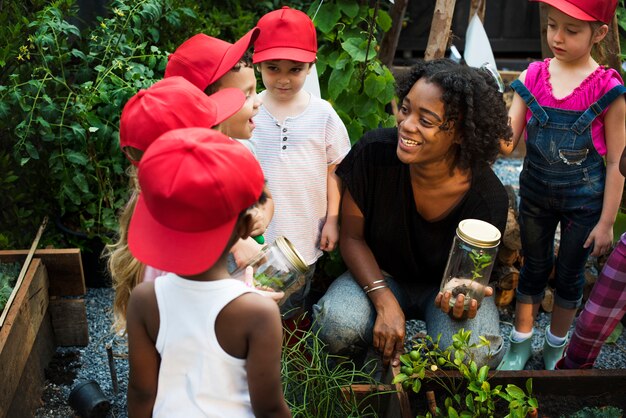Homeschooling in US: What’s Driving this Growing Trend?

The growing trend of homeschooling in the US is primarily driven by parents seeking greater control over their children’s education, curriculum choices, and learning environments, alongside evolving perspectives on academic flexibility and personalized learning experiences.
The landscape of education is continuously evolving, and among the most significant shifts gaining momentum is the growing trend of homeschooling. This alternative education option, once considered niche, is now a mainstream choice for millions of families across the United States. But what exactly is the growing trend of homeschooling: what’s driving parents to choose alternative education options?.
The Shifting Educational Landscape: A Macro View
The realm of education has always been dynamic, adapting to societal changes, technological advancements, and evolving pedagogical philosophies. Historically, public and private institutional schooling dominated, embodying a standardized approach to learning. However, recent decades have witnessed a notable diversification in educational pathways, with homeschooling emerging as a prominent and increasingly appealing alternative.
This shift isn’t merely a statistical anomaly; it represents a fundamental reevaluation by parents regarding what constitutes an optimal learning environment for their children. It’s a complex decision influenced by a myriad of factors, ranging from academic concerns to deeply held family values. Unpacking this trend requires a nuanced understanding of both the push factors from traditional schooling and the pull factors inherent in the homeschooling model, revealing a mosaic of motivations that are collectively reshaping the future of education.
Historical Context of Homeschooling
Homeschooling is not a new phenomenon; in fact, formalized schooling is a relatively recent innovation in human history. For centuries, education was primarily home-based, intertwined with family life and apprenticeship. The modern resurgence of homeschooling in the U.S. began in the 1970s and 80s, driven initially by a desire for religious instruction and concerns over the quality of public education.
Early homeschoolers often faced legal challenges and societal skepticism. However, tenacious advocacy and compelling evidence of academic success gradually led to widespread legal recognition and acceptance. Today, homeschooling is legal in all 50 states, with varying regulations, and supported by a robust ecosystem of curricula, co-ops, and resources. This historical journey from fringe movement to widely accepted educational choice underscores the adaptability and resilience of the homeschooling community.
- The 1970s and 80s marked the modern genesis of the homeschooling movement.
- Initial motivations largely revolved around religious freedom and academic concerns.
- Legal battles and advocacy were crucial in establishing homeschooling as a legitimate option.
- Today, homeschooling is legal in all states, though regulations vary significantly.
The statistical trajectory itself paints a compelling picture. Before the 2020 pandemic, the homeschooling population was already on a steady incline. The subsequent disruption to traditional schooling acted as a catalyst, introducing countless families to homeschooling out of necessity. Many discovered its benefits and chose to continue, further cementing its place as a viable and preferred educational model. This historical and statistical backdrop is essential for grasping the current momentum of the homeschooling trend.
Beyond the Pandemic: Sustained Growth and Parental Motivations
While the COVID-19 pandemic undeniably triggered an unprecedented surge in homeschooling, a deeper analysis reveals that the current growth extends far beyond a temporary response to health crises. Prior to the pandemic, homeschooling rates were already experiencing a steady rise, indicating underlying societal shifts that were independently fostering its appeal. The pandemic, rather than initiating the trend, served as an accelerator, exposing a broader demographic of parents to the practicalities and benefits of home-based learning.
Many families, out of necessity, experienced homeschooling firsthand and, surprisingly, found it to be a profoundly positive and effective educational model for their children. This experiential learning often dispelled misconceptions and highlighted advantages that were previously unrecognized. Consequently, a significant portion of these “pandemic homeschoolers” chose to continue, driven by newly discovered convictions about their children’s educational needs and their own capacity to meet them. This sustained growth points to more fundamental shifts in parental priorities and expectations for education.
Academic Concerns and Curricular Control
A primary driver for many parents considering homeschooling is dissatisfaction with the academic environment, content, or pace in traditional schools. This concern often stems from a desire for more rigorous academics, a tailored curriculum, or simply a different approach to learning that may not be available in conventional settings.
- Parents often seek a more individualized academic approach for their children.
- The ability to customize curriculum and learning pace is a major draw.
- Concerns about a lack of academic rigor or specific subject offerings in public schools.
For some, it’s about addressing learning differences or giftedness that can be difficult to accommodate in a large classroom setting. For others, it’s about ensuring a deeper dive into subjects aligned with family values or future goals, unconstrained by standardized testing pressures or broad curriculum mandates. The flexible nature of homeschooling allows for a direct alignment between educational goals and daily instruction, often leading to more engaged and focused learners.
Personalized Learning: Tailoring Education to Each Child
In an era that increasingly recognizes the unique strengths and learning styles of individual children, the concept of personalized learning has gained significant traction. While traditional schools strive to offer differentiated instruction, the inherent structure of classrooms with multiple students often limits the extent to which true individualization can occur. This limitation is a powerful impetus for parents to explore homeschooling, where the educational journey can be meticulously crafted to fit each child’s specific needs, interests, and pace.
The ability to tailor a curriculum provides an unparalleled advantage for children who may thrive at a faster pace, benefit from a slower, more deliberate approach, or require alternative methods of instruction to grasp complex concepts. Whether a child is an auditory, visual, or kinesthetic learner, homeschooling allows parents to adapt their teaching strategies and resource selection to maximize engagement and comprehension. This level of customization ensures that learning is not a one-size-fits-all endeavor, but rather a dynamic process that evolves with the child.
Addressing Learning Differences and Giftedness
A significant motivation for many homeschooling families is the need to address specific learning differences or to adequately challenge gifted children. Traditional school systems, despite their best efforts, often struggle to provide the tailored support or advanced opportunities that these students require.
For children with learning disabilities, homeschooling can offer an environment free from the distractions of a large classroom, allowing for intensive, one-on-one instruction and the flexibility to explore different teaching methodologies until effective ones are found. Similarly, gifted children often languish in conventional settings, their intellectual curiosity unfulfilled. Homeschooling allows them to accelerate their studies, delve deeply into passion areas, and pursue advanced topics typically reserved for older students. This individual focus often leads to greater academic achievement and improved emotional well-being.

- Homeschooling allows for customized pacing, beneficial for both advanced and struggling learners.
- Parents can select resources and teaching methods that align with a child’s unique learning style.
- Children with learning differences receive focused, distraction-free instruction.
- Gifted children can pursue advanced topics and accelerate their learning without limitations.
The flexibility extends beyond just academic content. It encompasses the learning environment itself – choosing times of day, locations, and even the social context in which learning takes place. This holistic approach to personalization ensures that education becomes a truly enriching and highly effective experience for a diverse range of learners, fostering a love for learning that goes beyond test scores.
Safety, Environment, and Family Values
Beyond academic considerations, a deeply personal and often compelling set of reasons propel parents towards homeschooling: concerns about safety, the social environment of schools, and the desire to instill specific family values. These factors often intertwine, reflecting a comprehensive vision for a child’s upbringing that extends beyond the classroom walls.
The immediate environment in which a child spends a significant portion of their day profoundly impacts their development. Parents are increasingly evaluating this environment, seeking settings that align with their protective instincts and moral compass. This comprehensive assessment of how education integrates with their broader parenting philosophy is a critical aspect of the homeschooling decision for many families, highlighting that education is not merely about academics, but about holistic development within a supportive and values-driven framework.
Concerns Over School Safety and Bullying
Unfortunately, school safety remains a prominent concern for many families. Reports of bullying, violence, and general insecurity within school environments often push parents to seek alternatives where they feel they can better protect their children. The desire to create a physically and emotionally safe learning space is a powerful motivator.
While schools strive to provide secure environments, the sheer number of students and unpredictable social dynamics can make it challenging to mitigate all risks. Homeschooling offers parents direct control over their child’s social interactions, allowing them to curate friendships and manage exposure to negative influences. This sense of security provides peace of mind and enables children to learn in a calmer, less anxious setting.
- Physical safety and emotional well-being are paramount for many parents.
- Concerns about bullying and negative peer pressure are substantial drivers.
- Homeschooling offers a controlled social environment for children.
- Parents can actively shape their child’s social experiences and friendships.
Furthermore, the increased focus on mental health in recent years has drawn attention to the impact of school environments on a child’s psychological well-being. For some children, the pressures of traditional schooling, including academic stress, social hierarchies, and exposure to various forms of negativity, can be overwhelming. Homeschooling provides an opportunity to mitigate these stressors, fostering a more nurturing and low-pressure environment where a child can develop at their own pace, free from the anxieties that can sometimes pervade conventional school settings.
Flexibility and Lifestyle Integration
One of the most appealing aspects of homeschooling for many families is the unparalleled flexibility it offers. Unlike the rigid schedules and fixed routines of traditional schooling, home education can seamlessly integrate with a family’s unique lifestyle, commitments, and developmental rhythms. This adaptability extends beyond mere scheduling and encompasses every facet of the learning process.
For families with parents who travel frequently for work, or those who wish to embark on extended educational trips, homeschooling removes the constraints of attendance requirements and fixed academic calendars. It allows for spontaneous learning opportunities, such as visiting historical sites during off-peak seasons, engaging in hands-on projects that require more time than a school day permits, or simply adapting the learning schedule to align with a child’s natural energy cycles. This inherent flexibility transforms education from a separate, insular activity into an organic component of family life.
Tailoring Schedule and Pace
The traditional school day follows a set timetable, often regardless of a child’s individual needs or the dynamics of family life. Homeschooling breaks free from these constraints, allowing families to design a schedule that works best for them.
This might mean a later start for a night owl, longer breaks for active children, or an intensive study period followed by a day dedicated to extracurricular interests. The ability to pace learning according to a child’s absorption rate means no one is left behind or held back. This adaptability creates a less stressful and more effective learning environment, maximizing engagement and retention.

- Homeschooling allows for custom daily and weekly schedules.
- Learning can be adapted to a child’s natural rhythms and interests.
- Flexibility for travel, extracurriculars, and family time is a major draw.
- No fixed academic calendar, enabling breaks and learning experiences based on family needs.
Beyond daily routines, homeschooling offers the freedom to integrate learning with real-world experiences. Field trips become more frequent and meaningful, extending beyond mere excursions to laboratories for practical application of learned concepts. The world itself becomes a classroom, whether through travel, community engagement, or simply the daily tasks of running a household. This integration of learning into daily life makes education more tangible and relevant, fostering a deeper understanding of how academic concepts apply to the real world.
The Evolving Landscape of Homeschooling Resources and Support
The growth of homeschooling isn’t just about parental desire; it’s also about the significant evolution and expansion of resources and support systems available to homeschooling families. What was once a relatively solitary endeavor has blossomed into a vibrant, interconnected community bolstered by a wealth of curriculum options, technology, and local networks. This transformation has made homeschooling more accessible, manageable, and appealing to a broader demographic of parents.
The sheer variety of educational materials now available is staggering. From traditional textbooks and workbooks to elaborate online platforms, interactive software, and comprehensive unit studies, parents can choose curricula that align with their preferred educational philosophies and their children’s learning styles. This diverse marketplace of resources has democratized access to quality educational content, allowing parents to piece together a personalized learning experience tailored to their unique needs and objectives, removing one of the major barriers for considering this educational path.
Online Resources and Virtual Learning
The digital age has revolutionized homeschooling, providing an unprecedented array of online resources, virtual schools, and interactive learning platforms. This accessibility has lowered the barrier to entry for many parents who might have felt overwhelmed by the prospect of sourcing all educational materials themselves.
From complete online school programs with accredited teachers to individual courses, educational videos, and massive open online courses (MOOCs), the internet offers a vast trove of learning opportunities. These resources can supplement a parent-led curriculum, provide specialized instruction in challenging subjects, or even form the backbone of a child’s entire educational program, making homeschooling more viable than ever before. The ability to learn from anywhere, at any time, has greatly enhanced the appeal and practicality of home education.
- Digital platforms offer diverse curriculum options, from full courses to supplemental materials.
- Online resources provide flexibility and access to specialized instructors.
- Virtual learning has opened homeschooling to families with varying pedagogical approaches.
- Technology makes homeschooling more manageable and less reliant on physical resources alone.
Beyond digital resources, the growth of homeschooling has fostered a robust network of local support groups, co-ops, and extracurricular activities. These communities provide opportunities for social interaction, shared learning experiences, and valuable peer support for both children and parents. Field trips, sports leagues, art classes, and academic clubs specifically designed for homeschoolers are now common, dispelling the myth of social isolation and ensuring that homeschooled children have ample opportunities for socialization and community engagement. This rich ecosystem of support is a crucial factor in the sustained growth and perceived viability of homeschooling.
Addressing Common Misconceptions About Homeschooling
Despite its growing prominence and the increasing availability of resources, homeschooling often remains shrouded in misconceptions. These misunderstandings can deter parents who might otherwise benefit from this educational approach, painting a picture that doesn’t fully reflect the reality of modern home education. Addressing these common concerns is essential to providing a balanced understanding of the movement.
One of the most pervasive myths revolves around socialization, suggesting that homeschooled children are isolated and lack social skills. In truth, many homeschooling families actively seek out diverse social opportunities, often resulting in children who are well-adjusted and capable of interacting with a wide range of age groups and backgrounds. Dispelling these myths is crucial for parents to make informed decisions, ensuring they base their choices on accurate information rather than outdated stereotypes about this dynamic educational option.
Socialization: Beyond the Classroom Myth
Perhaps the most persistent misconception about homeschooling is the idea that homeschooled children lack adequate socialization. Critics often assume that without the daily interaction of a traditional classroom, children will become socially awkward or isolated. This view often overlooks the rich and varied social opportunities available to homeschooled children today.
Modern homeschooling rarely means a child is confined to their home. Instead, parents actively seek out numerous avenues for social interaction. These include involvement in homeschooling co-ops, sports teams, community clubs (e.g., Scouts, 4-H), volunteer work, church groups, and regular meet-ups with other homeschooling families. In fact, many argue that homeschooling provides a more diverse and authentic form of socialization, as children interact with people of all ages and backgrounds, rather than being limited primarily to peers of the same age.
Moreover, homeschooled children often develop stronger bonds with their families and have more opportunities for independent thought and self-direction. They learn to navigate various social settings, build friendships based on shared interests, and engage in meaningful interactions that extend beyond the typical classroom dynamic. This broader exposure often fosters greater maturity, adaptability, and confidence in navigating the real world, challenging the traditional notion that a classroom is the sole or indeed the best crucible for social development.
| Key Factor | Brief Description |
|---|---|
| 📚 Personalized Learning | Ability to tailor curriculum to child’s pace and style. |
| 🛡️ Safety & Environment | Concerns about school safety and desire for values alignment. |
| ✈️ Flexibility & Lifestyle | Adapting education to family travel or unique schedules. |
| 💻 Resource Availability | Increased access to online tools and community support. |
Frequently Asked Questions
Yes, homeschooling is legal in all 50 states in the U.S. However, the specific regulations and requirements for homeschooling vary significantly from state to state. Parents should research their state’s laws regarding curriculum, attendance tracking, and assessment to ensure compliance.
Numerous studies suggest that homeschooled children often perform at or above their traditionally schooled peers on standardized tests. The individualized attention and tailored curriculum often contribute to strong academic outcomes. Success, however, varies based on parental commitment and educational approach.
Homeschooled children typically have diverse social opportunities through co-ops, community groups, sports teams, clubs, and volunteer work. They often interact with a wider age range of people, leading to well-rounded social skills that extend beyond peer-group dynamics.
Key challenges include parental time commitment, financial considerations, ensuring adequate resources, and navigating potential burnout. Parents must also adapt teaching styles and manage educational planning, which can be demanding despite its rewards.
Absolutely. Homeschooled students are regularly accepted into colleges and universities, often gaining admission to prestigious institutions. Colleges typically evaluate homeschooled applicants based on transcripts, test scores, portfolios, and essays, in much the same way as traditionally schooled students.
Conclusion
The growing trend of homeschooling reflects a profound evolution in how families approach education, moving beyond the traditional institutional model towards alternative options that prioritize individualized needs, safety, and values alignment. What began as a niche movement has matured into a robust educational choice, supported by a wealth of resources, a thriving community, and increasing societal acceptance. While misconceptions persist, the compelling benefits of personalized learning, flexible lifestyles, and a values-driven environment continue to draw more parents to this path. As the educational landscape continues to diversify, homeschooling stands as a powerful testament to parental agency and the enduring pursuit of the best possible learning experience for every child, shaping not just individual futures but the broader narrative of education itself.





